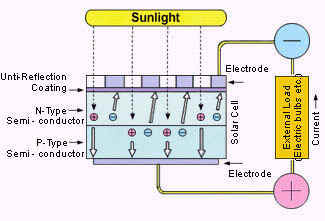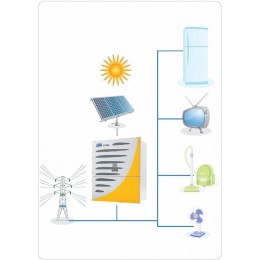Solar System
Solar System
When power is supplied to small loads, diesel generators are too expensive in long-term operation. Subjected to mechanical wear and tear, they also need regular refueling and specialized maintenance. After a while, they need to be replaced.
A better alternative is solar energy. Reliability, low-maintenance, and the ability to deliver power in practically any environment make photovoltaic ideal for cost effective use in systems such as telecommunication.
Key Benefits
|
|
|
|
|
|
|
|
|
|
Solar Cell Mechanisms

A solar cell is made of 2 types of semiconductors, i.e. N-type (more electrons- negative charge) and P-type (more holes- positive charge) semiconductors. These are bonded together and an electrode is attached to each of them.
When the solar cell is exposed to sunlight, both negative and positive charges are created. The former is segregated to the N-type while the latter is segregated to the P-type, producing a potential between the 2 electrodes. When a solar cell at this state is connected to an external load such as an electrical bulb, the electrical current flows and the bulb lights up.
Solar Systems Components
Solar Systems have to meet high standards of reliability and economic efficiency. This can only be guaranteed by the use of field-proven quality components that are well-matched.
Solar Modules
Solar modules gather solar energy in the form of sunlight and convert it into DC electricity. The more sunlight they receive, the more electricity they produce. The number of modules used in your system depends on your power needs and the amount of sunlight available. The following is the types of solar modules:
- Mono-Crystalline Silicon Modules
- Poly-Crystalline Silicon Modules
- Thin Film Modules
Mounting Structure & Interconnects
Mounting structures hold the solar modules securely in place. Ground, roof and pole mounting versions are available. Proper wiring and connections must be specified for every segment of the system to assure best performance. Solar modules should be installed in an area that is generally free from shade and receives as much direct sun exposure as possible.
Inverters & Batteries
For standby solar systems, while batteries store the energy generated by the solar modules, charge regulators are the link between the modules, battery and electrical load. They protect the battery from overcharge or excessive discharge.
For grid-tied solar systems, inverters convert DC to AC electricity which is used to run many common appliances and equipment.
Backup Generator
Compatible generators (i.e. diesel) may be used as backup for excessive power demands or during unanticipated long sunless periods.
Maintenance
Solar systems are one of the easiest and most reliable ways to generate electricity. Regular maintenance to check wiring, connections, batteries and overall system condition will help assure long-term trouble-free operation.



